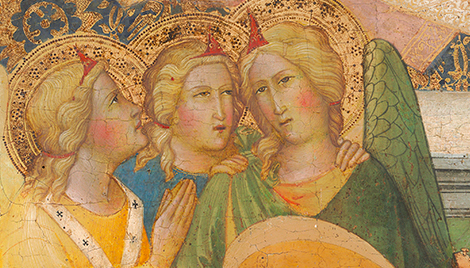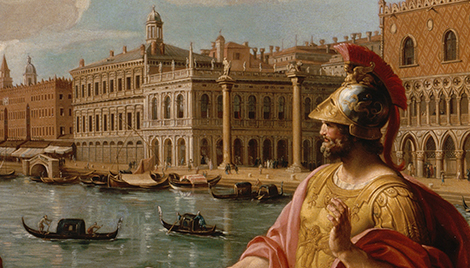Kress Collection Highlights from the 2021 Annual Report
Each year the Samuel H. Kress Foundation publishes an annual report that presents a detailed overview of the Foundation’s activities from the previous fiscal year. In addition to a letter from our president, details on grant and fellowship recipients, and financial information, the report incorporates artworks from the Kress Collection held in repositories across the United States, usually within a particular theme.
The Annual Report for Fiscal Year 2021 is now available on our website and explores the visual theme of architecture and the built environment. Keep reading for a selection of Kress Collection highlights from this year's report, including links to further resources.
Left: Ercole de' Roberti, Giovanni II Bentivoglio, c. 1474/1477, Samuel H. Kress Collection, National Gallery of Art; Right: Ercole de' Roberti, Ginevra Bentivoglio, c. 1474/1477, Samuel H. Kress Collection, National Gallery of Art
Canaletto, View of the Grand Canal, late 1720s, Samuel H. Kress Collection, Birmingham Museum of Art
One of the most highly regarded vedute, or view, painters of eighteenth-century Venice, Canaletto painted more than one hundred images of the Grand Canal alone. His paintings were most popular with tourists, especially from England, who visited Venice on the Grand Tour.
This painting in the collection of the Birmingham Museum of Art captures the everyday activity and movement of the Grand Canal, focusing on a group of gondoliers while onlookers peer out from the palazzos along the water.
For further information on this painting and others by Canaletto from the Samuel H. Kress Collection, visit the Kress Collection page on our website.
Canaletto, The Porta Portello, Padua, c. 1741/1742, Samuel H. Kress Collection, National Gallery of Art
Canaletto's view of Padua exudes a softness and luminosity that stands in contrast with the sharpness of his more widely known Venetian city scenes, such as the one above.
Here, the architecture is likely a composite view with some buildings drawn from Canaletto's own imagination. The artist suggests the forms of figures with dots of paint in blue, red, green, gold, and white. In focusing on the Porta Portello, the main entrance to the city, Canaletto at once emphasizes the energy of the working waterfront and the quotidian nature of life in the ancient city.
For further information on this painting and others by Canaletto from the Samuel H. Kress Collection, visit the Kress Collection page on our website.
Salomon van Ruysdael, River View of the Nijmegen with the Valkhof, 1648, oil on canvas, Samuel H. Kress Collection, Fine Arts Museums of San Francisco
In this Dutch landscape, Salomon van Ruysdael captures a dramatic view of the Valkhof, an early medieval castle founded by Charlemagne, rising above the river Waal at Nijmengen. Sweeping, painterly clouds reflect the golden light of the setting sun, contrasting against the bright, blue sky. Scattered boats, a ferry delivering passengers and goods, a group of cattle, and a distant church and windmill signal the quiet energy of everyday life amidst the drama of this looming, medieval structure.
Visit the Kress Collection page for more information on this painting.
Giovanni Paolo Panini, Interior of the Pantheon, Rome, c. 1734, Samuel H. Kress Collection, National Gallery of Art
In this view of the Pantheon in Rome, one of many by Giovanni Paolo Panini, the artist manipulates the perspective to show a larger view of the building than would be possible from any singular vantage point. Here, the exaggerated dome and enlarged oculus allow for a greater sense of depth and volume in the composition.
Each of Panini’s Pantheon paintings are differentiated by the diverse cast of characters that populate the interior. These individuals are drawn from a repertory of “types” that he and his studio developed around 1730 and continued to use for decades. In this work, fashionable women, clerics, tourists, and devotees animate the ancient interior, bringing this architectural marvel of the second century up to the artist’s contemporary moment of the mid-eighteenth century.
Visit the Kress Collection page for more information on this painting.
Gerrit Adriaensz Berckheyde, The Fish Market and the Grote Kerk at Haarlem, c. 1675-80, Samuel H. Kress Collection, North Carolina Museum of Art
Gerrit Berckheyde returned to the subject of Grote Market in Haarlem many times in his career, capturing the bustling scene with a detail and precision typical of Dutch painting in the seventeenth century.
Here, the artist focuses on a series of fish stalls situated in the shadow of Grote Kerk, a monumental Protestant church, with the City Hall visible in the distance. The composition is bathed in a golden light, illuminating the striking architecture of the buildings of this central market square.
Visit the Kress Collection page for more information on this painting.
See these works and more featured in the Foundation's 2021 Annual Report!



